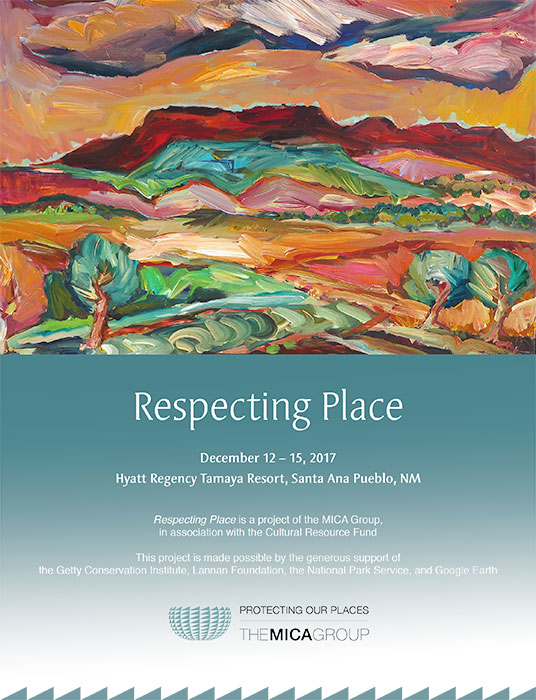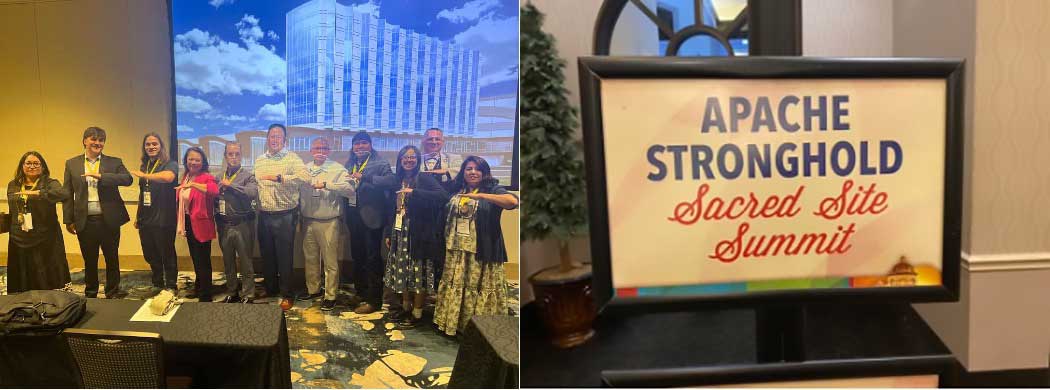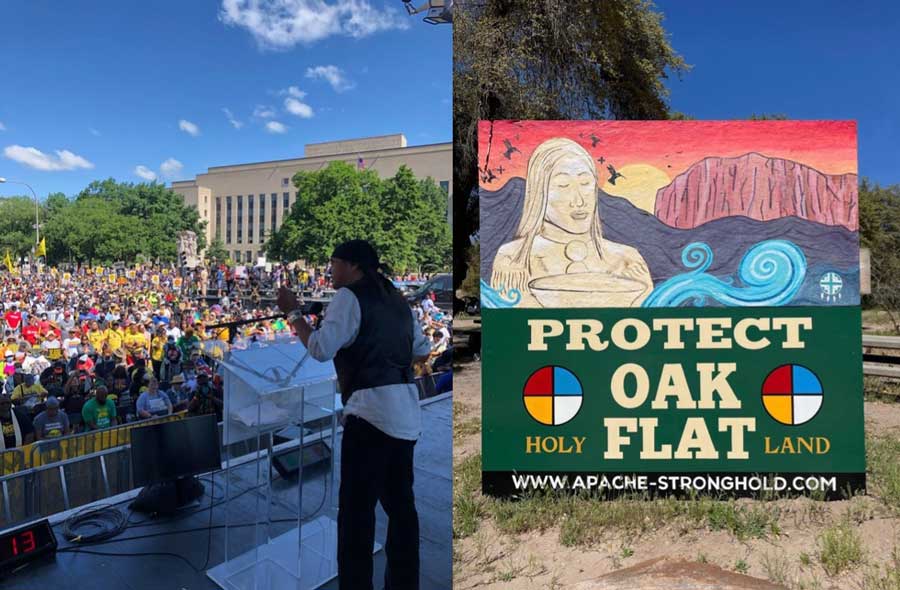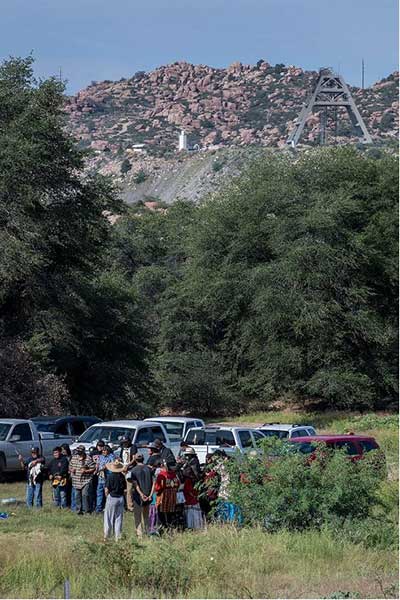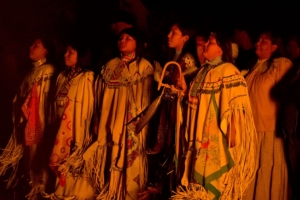On-The-Ground Projects
MICA has supported Tribal Nations in protecting 52 significant cultural sites. Here is a small sampling of our projects protecting places in tribal communities:
Confederated Tribes of the Colville Reservation (WA) (2 projects)
Spiritually Significant Rock Features of the Moses Coulee Region of Washington State
Supported the Colville Tribes in documenting and evaluating ethnographic rock features within the Moses Coulee region of Washington State for potential inclusion in the National Register of Historic Places.
Collaborative Site Protection Planning with The Nature Conservancy
Supported the Colville Tribes in launching a collaboration between the Tribes’ History and Archaeology Program and The Nature Conservancy to develop and implement an Interim Site Protection and Management Plan for TNC-managed lands within the Moses Coulee and Beezley Hills Preserve.
“[This project] has been critical to the establishment of a strong partnership between the Confederated Tribes of the Colville Reservation and The Nature Conservancy. Development of the plan laid the groundwork to address our long-standing concerns about the protection and management of archaeological sites and traditional cultural properties in the greater Moses Coulee region.”
Koi Nation of Northern California (2 projects)
Cultural Landscape Protection and Awareness
MICA supported the Koi Nation in creating a documentary film on the history of their people and homeland, now a state park. The Koi have developed an excellent relationship with park officials and were invited to patrol the park to protect it. MICA assisted the Nation in purchasing a vehicle for tribal members’ use to co-manage their homelands. When tribal members found evidence of looting in the park, MICA supported them in producing a second documentary on archeological crimes, which won a local Emmy and was broadcast on the local PBS channel.
Anderson Marsh State Historic Park Protection Plan
Supported the Nation in replacing signs that inform park visitors of penalties for archeological crimes, provided stipends for tribal members’ training to monitor the park, and provided 1,000 copies of the “Saving the Sacred” video to state municipalities.
“MICA truly kept the Koi Nation on a stream of emotional steadiness by continuing to support us through our struggles in partnering with a state agency to protect our homelands, Anderson Marsh State Park. We have been able to gain confidence in our abilities and bring in the next generation to help them understand what it means to protect our ancestors.”
Kaw Nation (OK)
Chilocco Indian Boarding School Improvement Project
The Chilocco Children’s Cemetery had fallen into disrepair. All but one of the graves no longer had markers, and the fence protecting the graves had fallen down. MICA supported the Kaw Nation in replacing the fence and improving the service road leading to the cemetery and helped design a granite memorial and contemplation bench to honor the children who passed away at the Chilocco Indian School.
“This project established a rapport with the five local tribes who currently co-manage the cemetery. We now know what can be accomplished when we work together for a common good. Most importantly, this project stands as a tribute to 67 children who lost their lives very far away from home, family, and friends.”
Walker River Paiute Tribe (NV) (2 projects)
Tribal Rock Art Documentation
Documented and recorded a petroglyph and pictograph site located within the Walker River Paiute Reservation. Supported the Tribe in clearing the site of wildfire fuels that can permanently damage the petroglyphs and in partnering with the Nevada Department of Transportation, which will clear culverts under a highway near the petroglyphs to reduce flooding.
Cultural Resource Survey of Prehistoric Carson/Walker Lake Trail
Supported the Tribe in re-establishing its Cultural Board. The Board conducted a comprehensive cultural resources survey of the prehistoric Carson/Walker Lake Trail, created reports for the tribal archives, and shared the reports with other tribal departments for their use in producing maps and protecting areas from damage from grazing and trespassing.
“[This project] helped to create more awareness within our Tribe of cultural loss and the importance of preservation efforts to save what is left. Our language, culture, and history are in their penultimate stage of existence. All that we do or don’t do now will determine whether we continue to exist as Agai Tukadu Numu or become nothing more than a footnote in an anthropology report.”
Cow Creek Band of Umpqua Tribe of Indians (OR)
Huckleberry Patch Special Interest Area Enhancement
Huckleberries are a vital traditional cultural food for the Cow Creek Umpqua Band. MICA supported Cow Creek in partnering with the U.S. Forest Service on a Huckleberry Patch Special Interest Area Enhancement Project to restore the huckleberry in severely burned areas.
“The benefits from [this project] have added value to the Cultural Resources Program by allowing us to meet one of our strategic goals: the effective management of cultural resources within our Ancestral Territory.”
Catawba Indian Nation (SC)
Yehasuri Trail Revitalization Project
The Yehasuri Trail is one of the most culturally, spiritually, ecologically, and historically significant places in the Catawba community. MICA supported the Catawba Tribe in addressing water erosion along the trail by funding an expert consultant who established swales, berms, and a wildflower meadow to reduce water runoff.
“[This project] has meant that more of our people are able to access one of the most significant sites for our Nation, and while on this site, they are better able to work with the medicinal plants and take care of the trail itself.”
La Posta Band of Mission Indians (CA) (2 projects)
Site Survey and Evaluation
Supported La Posta in hiring archaeologists and training Tribal Monitors to revisit 30 prehistoric sites last surveyed in 1982. Monitors and archaeologists identified previously undiscovered cultural sites. MICA supported La Posta in geo-mapping the sites in consultation with La Posta Tribal Elders to develop plans to protect the sites.
The La Posta Archaeological Field School
Supported La Posta in partnering with the University of California San Diego Archaeology Department to work with the Tribal Archaeologist to create an ongoing archaeological field school on La Posta lands.
“This partnership means that we will never truly lose the sites we are recording, that the Kumeyaay now have a voice in the training of future archaeologists and are no longer relying on others to dictate their formal history to them.”
Stockbridge Munsee Band of Mohicans (WI)
Preserving Our Place on Stockbridge, Massachusetts, Main Street
Supported the Stockbridge-Munsee Band in surveying Laurel Hill in Stockbridge, MA, a Mohican historic site, to revise the Massachusetts State Inventory and National Register of Historic Places listings on the Stockbridge Main Street Historic District to include Mohican cultural sites.
“The site documentation work complements our Main Street Walking Tour efforts to raise the visibility of Mohican history throughout the town [of Stockbridge, MA] and has opened valuable conversations regarding possible interpretive signage and overall recognition of the buried past. Documenting, mapping and recording home sites presents proof of our existence that cannot be denied, and gives the opportunity for members of our Tribe to meaningfully pay respects and engage with the lands of our direct ancestors.”
Lower Sioux Indian Community (MN)
Cansayapi: Protecting Our Place
Supported Lower Sioux in identifying and geo-mapping all historic and cultural landscape properties on their reservation. Lower Sioux developed standard survey forms, a digital GIS-cataloging system, and a public access platform to protect their lands in the event of oil pipelines and other infrastructure dangers.
“[The project] allowed our Tribe to strengthen a framework for an underserved, underutilized area of our tribal government. We now have the technology and personnel to be an ally in the protection, management, and preservation of cultural resources and site work long into the future.”
Nez Perce Tribe (ID)
pipíis’nim sepe’yéew’cix (Letting the Ancestors Rest): Protecting Nez Perce Burial Grounds
Supported the Nez Perce Tribe in locating, documenting, and mapping previously unrecorded cemeteries and ancient burial grounds; educating and collaborating with landowners and community members to identify site protection strategies; and entering the collected data into an ArcGIS geodatabase for ongoing management and protection.
“This project was important to us because it showed us a concrete glimpse of our larger land base as a people…the burial locations of our tribal members serve as concrete indicators of our aboriginal territory, and thus affirm our ancestry, sovereignty, and collective responsibility to care for our traditional homeland.”
Ohkay Owingeh (NM) (2 projects)
Kiva Restoration Project
Supported the Pueblo in restoring structural integrity to a damaged historic kiva. Erected in the early 1800s, the kiva was used as the main venue for the Pueblo’s traditional dances. In a second project, MICA supported the Pueblo in conducting additional renovations to the kiva to improve access for Elders and disabled persons, allowing Ohkay Owingeh to continue to practice their sacred and spiritual dances in its ceremonial chamber.
Oneida Indian Nation (NY)
Historic and Cultural Preservation Plan
The Oneida Nation signed an historic intergovernmental agreement with New York State and Madison County, that provided certainty as to the Nation’s ownership and stewardship of the land. MICA supported the Nation in 1) identifying best practices for protecting historic and cultural, places, 2) creating protocols for the return of cultural items and for the preservation of artifacts in the Nation’s archives, and 3) publishing an Historic and Cultural Preservation Plan.
“The Historic and Cultural Preservation Plan provides solid guidance for the Nation on how to address questions on preservation, archival protocols, the repatriation of Oneida ancestors and objects of cultural patrimony, communications with agencies, and coordination with academics, avocational archaeologists, historians, and other parties.”
Osage Nation (OK)
Cultural Education and Preservation Project – Historic Sugarloaf Mound
MICA supported visits of tribal members and cultural resources staff to sacred sites and places of significance to the Osage Nation. The Tribe purchased Sugarloaf Mound, an important sacred site for the early ancestors of the Osage Nation who once lived in what is now St. Louis, MO, from private owners. MICA supported the Tribe in stabilizing Sugarloaf Mound, deconstructing a private home on the mound, and restoring the mound’s landscape.
“[The project] allowed tribal members to experience ancestral sites in places never visited before.”
“The stabilization and preservation of Sugarloaf Mound allowed this extremely significant site to be protected and to survive into future years. Without it, the adverse effects of the deteriorating house on the mound would likely have led to the mound’s eventual collapse. The project contributed to the important need for [the mound’s] long-term preservation as a sacred site and as a future location of interpretation and education.”
Pueblo of Acoma (NM) (2 projects)
Acoma NAGPRA Consultation Project
Supported the Pueblo in developing a Repatriation and Reburial Policy to guide federal agencies in how to work with the Tribe to repatriate and re-bury ancestor remains.
“[This project] provided the tribe with tremendous opportunities to rebury our ancestral remains back to our homelands and also to repatriate items of cultural patrimony back to the Tribe.”
Preserving the San Esteban del Rey Mission
Acoma Pueblo ancestors built the San Esteban del Rey Mission as slave labor in the early 1600s. Now a tourist destination on Acoma tribal lands, the Mission is one of the 100 most endangered sites in the world, according to the World Monuments Fund. MICA supported repairs to prevent further deterioration.
“[This project] has meant many things for the tribe, but the one thing that stands out the most is a sense of “Hope”…that there is still hope for the Tribe to fix things that really matter to them.”
Pueblo of Santa Clara (NM)
Cultural Survival Kit Project
MICA supported the Pueblo of Santa Clara’s Tribal Historic Preservation Office in allowing ten pueblo youth, ages 14-20, to visit four cultural heritage historic sites to experience first-hand the prehistoric structures, petroglyphs, and artifacts left by our ancestors and the immense effort needed to sustain these sites. The youth took part in preservation exercises, learned about careers in historic preservation, and now understand the Pueblo’s migration story and route to their present Pueblo near Española, NM.
“The Cultural Survival Kit provided a great opportunity for Pueblo youth to establish a life-long interest in archaeology, preservation, and restoration efforts.”
Sisseton Wahpeton Oyate (SD)
Tribal Register of Historic Places
Supported Sisseton Wahpeton in implementing a Tribal Register of Historic Places, which now serves as an official list of the Sisseton Wahpeton Oyate’s historic places.
Tejon Indian Tribe (CA)
Preserving the Power of Place: Cultural Preservation Collaboration
Supported Tejon in a project involving the Tribe, the Wind Wolves Preserve, and the University of Central Lancashire, U.K. to protect the Preserve from becoming a toxic waste dump. The partnership ensured that the Preserve, an immensely significant tribal cultural resource, world-class archaeological site, and the homeland of the Tejon Tribe, will be protected.
“By completing the ethnogeographical component of the project, the Tribe is now able to visualize/appreciate the full extent of the “Kitanemuk Sphere of Influence” (i.e. the Tribe’s ancestral territory and beyond) for the first time ever! This represents a major point of pride for the Tribe, and we have been having A LOT of fun sharing it with our Tribal Members and showing it to our partners.”
Mescalero Apache and San Carlos Apache Tribes (NM)
Spirits in the Canyon: Documentation of Apache Rock Art in Spirit Canyon, Gila National Forest
MICA supported two Apache Tribes in working together to document rock art in Spirit Canyon in the Gila National Forest. In cooperation with the U.S. Forest Service, the Tribes decided which parts of Spirit Canyon will be open to the public. Elders participated, and youth recorded the Elders.
Cherokee Nation (OK) (2 projects)
Electronic Database for Site Preservation
MICA supported the Cherokee Nation in developing a GIS database for historic and cultural resources for the Cherokee Nation, the Oklahoma SHPO, Oklahoma Archaeological Survey, and the Eastern Band of Cherokee Indians to create a comprehensive, searchable system.
Rose Cottage: Protecting and Preserving Park Hill
MICA Supported the Cherokee Nation in utilizing non-invasive geotechnical surveys to investigate the historic and cultural significance of the Rose Cottage site in Park Hill, Oklahoma to further the Nation’s nomination of Rose Cottage to the National Register of Historic Places.
“MICA helped the Nation take a significant step in meeting one of our primary preservation goals: to survey, protect, and preserve a portion of the historic Rose Cottage site.”
Tulalip Tribes (WA) (3 projects)
Emergency Evacuations of Cultural Remains at Priest Point, Washington
In 2001, ancestral remains were exposed by construction at an ethnographically documented village site and potlatch house. Emergency excavations recovered over 156,000 faunal remains, lithic, bone, shell, and historic artifacts, and sediment samples. Prior to MICA’s involvement, this material remained unanalyzed and unreported. MICA supported Tulalip in developing a plan for analysis and reporting of records and collections of these ancestral remains.
Using the Archaeology of the Priest Point Site to Sustain Tulalip History
This project analyzed the recovered artifacts and ensured tribal input and participation. The data derived will be useful for the protection and enhancement of salmon and other species important to the Tribe and provide information about ancestral diet, lifeways, and habitats.
Archaeological Documentation and Survey of the Tulalip Tribe’s Reservation Coastline
Supported the Tulalip Tribes in recording the impact of climate change on resources on their reservation and on ceded lands. The project precisely located and described archaeological sites on the reservation and completed new assessments of areas along the shoreline containing sensitive archaeological material.
“Discovery by the project of an isolated projectile point in a shovel probe like those found as many as 5,000 years ago along with radiocarbon dates from shell middens as old as 1,500 years significantly extend ancestral occupation of the area.”
Blackfeet Nation (MT)
Cultural Resource Inventory and Early Sites Survey
Historians have mischaracterized the length of time Blackfeet ancestors have been in Montana. MICA supported the Blackfeet Tribe in conducting field surveys of ancient Blackfeet sites to locate bison kill sites. Working together, the Blackfeet Tribal Historic Preservation Office and University of Arizona archaeologists achieved findings that have made a significant contribution to archaeological research and were published with the full support of the Tribe.
“[The project] gave us an opportunity to locate significant sites of the Blackfeet and start the process for an interpretive center. [An] interpretive center has been talked about for decades. We now have the campaign manager, a professional fundraiser, and an architectural rendering to use for seeking funds.”


